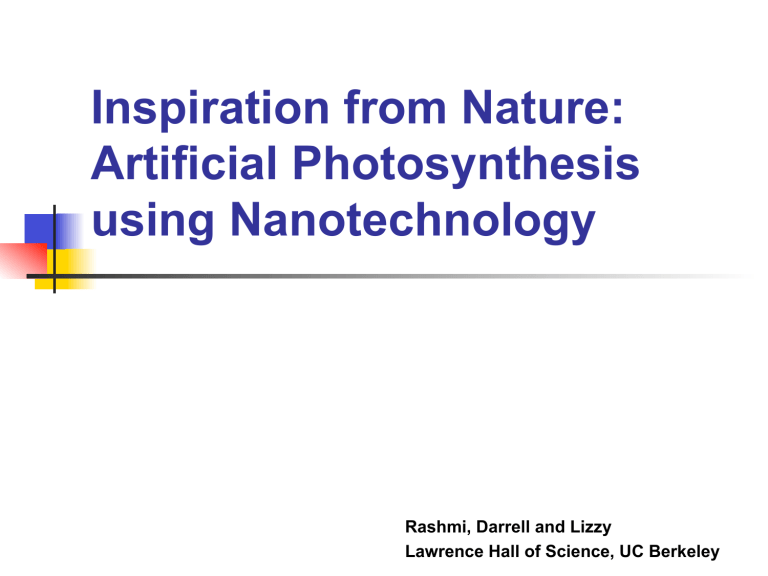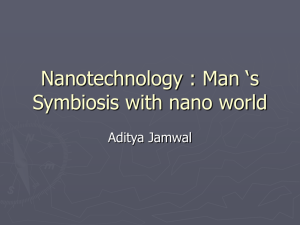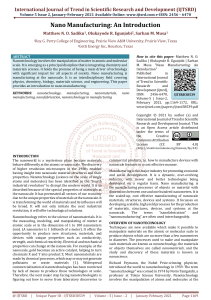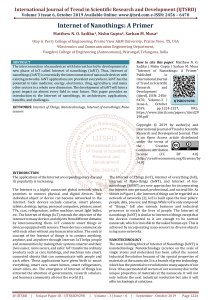Presentation for Prof. Pamela Muick`s biology class

Inspiration from Nature:
Artificial Photosynthesis using Nanotechnology
Rashmi, Darrell and Lizzy
Lawrence Hall of Science, UC Berkeley
Photosynthesis
Artificial photosynthetic system has to able to:
1.
Harvest Sunlight
2.
Split water molecules
What is Nanotechnology
Nanotechnology is the science dealing with the very small, of the order of 10,000 times smaller than a single strand of human hair.
Nanotechnology is the understanding and control of matter at dimensions between approximately 1 and 100 nanometers (nm), where unique phenomena enable novel applications.
Encompassing nanoscale science, engineering, and technology, nanotechnology involves imaging, measuring, modeling, and manipulating matter at this length scale.
Let us watch a video on nanotechnology ……… .
Unusual physical, chemical, and biological properties can emerge in materials at the nanoscale. These properties may differ in important ways from the properties of bulk materials and single atoms or molecules.
Material properties such as color, hardness, melting point change drastically at the nanoscale.
Even fluids flow differently!
tera giga mega kilo hecto deca deci centi milli micro nano pico
Scale Game
T
G
M k h da d c m
µ n p
1,000,000,000,000
1,000,000,000
1,000,000
1,000
100
10
1
0.1
0.01
0.001
0.000001
0.000000001
0.000000000001
10 12
10 9
10 6
10 3
10 2
10 1
10 0
10 ¯ 1
10 ¯ 2
10 ¯ 3
10 ¯ 6
10 ¯ 9
10 ¯ 12
Nano: Visualizing Size and Scale
Ø
A sheet of paper: 100,000 nanometers thick;
Ø
Single gold atom: a third of a nanometer in diameter.
Ø
A single strand of human hair: 10,000 nanometers thick
Nano: Visualizing Size and Scale
Key Ideas
1. Nanometer-sized things are very small, and often behave differently than larger things do.
2. Scientists and engineers have formed the interdisciplinary field of nanotechnology by investigating properties and manipulating matter at the nanoscale.
3. Nanoscience, nanotechnology, and nanoengineering lead to new knowledge and innovations that weren ’ t possible before.
4. Nanotechnologies have costs, risks, and benefits that affect our lives in ways we cannot always predict
Types of nanoparticle catalysts for producing Hydrogen from H
2
O
Manganese : Manganese is the catalyst found in the photosynthetic core of plants. A single atom of manganese triggers the natural process that uses sunlight to split water.
Cobalt oxide : One of the more recently discovered catalysts, clusters of nano-sized cobalt-oxide molecules (CoO) have been found to be stable and highly efficient triggers in an artificial photosynthesis system.
Dye-sensitized titanium dioxide : Titanium dioxide (TiO
2
) is a stable metal that can act as an efficient catalyst. It's used in a dyesensitized solar cell, also known as a Graetzel cell, which has been around since the 1990s. In a Graetzel cell, the nanocrystalline TiO
2 suspended in a layer of dye particles that capture the sunlight and
is then expose it to the TiO
2
to start the reaction.




